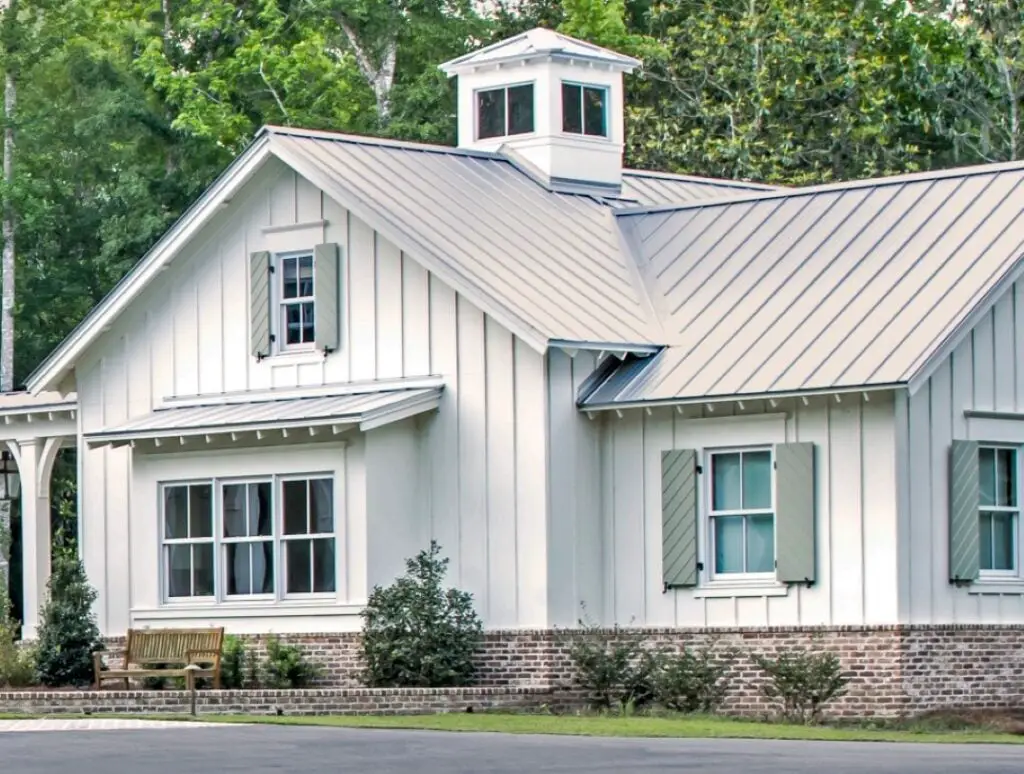Also see: Roof Cost Calculator
Table of Contents

Introduction
I’m a professional roof consultant, and I’ve spent a lot of time researching roof replacement costs for my clients. This means I keep up-to-date with changing material and labor costs for all kinds of roofing, including aluminum roofs. I thought keeping (and regularly updating) accurate aluminum roof cost estimates online would be a helpful resource for me, my clients, and homeowners in general, so here you go.
Aluminum is a great roofing material. One of the main advantages of aluminum is its exceptional resistance to corrosion. Aluminum naturally forms a protective oxide layer that significantly slows down further oxidation. This makes aluminum a particularly suitable roofing material in coastal or industrial environments where salt-laden air or pollutants can rapidly degrade steel. Aluminum’s corrosion resistance remains effective even when the surface is scratched, as the oxide layer reforms automatically. And while both steel and aluminum roof panels are almost always coated or painted at the factory, aluminum does not depend on its coating for its durability.
Aluminum is a premium roofing material, but much more affordable than copper. While aluminum still costs significantly more than asphalt shingles or most steel roofing options, aluminum’s longevity and low maintenance requirements can lead to favorable life-cycle costs. Aluminum roofs can last up to 80 years, and an aluminum roof will typically last around 25% longer than a steel roof under the same conditions. Aluminum is also 100% recyclable, allowing for recovery and reuse without degradation of properties, which supports sustainable building practices.
The cost of any particular aluminum roof will depend on several variables, including roof size, roof pitch, roof complexity, local labor costs, and the style of aluminum roof system chosen. Product quality also plays a big part as always. If you’re interested, you can see who I think makes the best metal roofing products.
The estimated prices I provide here are averages and should be considered ballpark figures to give you a general idea of the cost of an aluminum roof. On average, the cost of an aluminum roof in 2025 ranges from around $11 per square foot for exposed fastener aluminum panels to around $17 per square foot for standing seam aluminum systems. Aluminum shingles typically cost about $14 per square foot.
For an average 1,700-square-foot roof, total installed costs range from approximately $18,700 for exposed fastener panels to about $28,900 for standing seam aluminum. An aluminum shingle roof of the same size would cost around $23,800.
Also see my more general Metal Roof Cost Guide for cost details for other types of metal roofing.
Also see my Roof Replacement Cost Guide, which has typical current roof prices for other residential and commercial roofing materials.
Types of Aluminum Roofing
The tables below give typical aluminum roof prices according to the type of aluminum roofing system. There are several different types of aluminum roofing, and the specific system chosen will affect the roof’s cost, performance, appearance, and longevity.
Aluminum roofing systems, regardless of type, are valued for their light weight, corrosion resistance, and long service life. Most systems require little maintenance and come in a wide range of styles. To learn more about different systems and see what they look like, you should check out a few aluminum roofing manufacturer websites.
Standing Seam Aluminum Roofs
Standing seam aluminum roofs are very popular. These roofs are characterized by visible vertical seams that join the roof panels. They run continuously from the roof ridge down to the eaves. The raised seams conceal and protect the fasteners that attach the roof panels to the roof deck, and prevent leaks at fastener penetrations, which is one of the biggest issues on exposed fastener roofs. Standing seam aluminum panels typically have widths ranging from 12 to 24 inches, depending on design preferences and application requirements.
Due to their design, standing seam roof panels are not fixed in place by the fasteners, which allows the aluminum panels to expand and contract freely with temperature changes. This typically leads to better performance when compared to other system types.
Read more about standing seam roof costs.
Exposed Fastener Aluminum Panels
Exposed fastener metal roof panels are also known as through-fastened panels, screw down metal, ribbed panels, utility panels, R-panels, or they may even just vaguely be referred to as “corrugated panels.”
Exposed fastener aluminum roofing is one of the most cost-effective aluminum roofing systems available. It uses long panels that are fastened directly through the face of the panel to the roof deck or purlins using specialized screws with rubber gaskets to prevent leaks. These fasteners remain visible after installation, which gives the roof a more utilitarian appearance compared to concealed fastener systems like standing seam.
This type of aluminum roofing is commonly used on sheds, barns, cabins, and budget-conscious residential projects. While less expensive, it requires careful installation to avoid long-term issues with water intrusion around the fasteners. Deterioration of the fastener gaskets over time can eventually contribute to roof failure.
Panel widths typically range from 24 to 36 inches, and these aluminum panels will typically come in lengths of up to 22 feet.
Aluminum Shingles
Aluminum shingles are relatively small, interlocking metal tiles that are installed in courses using concealed fasteners. The bottom edge of each new shingle hooks over the top hem of the row below. Only the upper edge is nailed and the fasteners are concealed by the next course of shingles. Side flanges on the shingles interlock with adjacent shingles. Aluminum shingles offer homeowners the distinctive look and lightweight performance of metal roofing at a lower cost than standing seam aluminum systems. They may be stamped into shapes designed to resemble slate, wood shakes, or traditional architectural shingles.
Aluminum shingles are typically easier and faster to install than custom-fabricated panel systems, and they don’t require on-site seam forming. This helps reduce labor costs and makes them a more affordable option for residential applications. They are still a premium option compared to standard asphalt shingles, though.
Aluminum Panel Thickness (Gauge)
Aluminum roofing panels are typically manufactured in a range of thicknesses, referred to by their decimal thickness or gauge. Unlike steel, aluminum gauge numbers are not standardized across the industry, so it’s more accurate to reference the actual thickness in inches.
Common aluminum panel thicknesses used for residential roofing include:
- 0.032 inches – This is the most commonly specified thickness for architectural standing seam aluminum roofing. It offers a good balance between strength, durability, and workability.
- 0.040 inches – A heavier option used where increased strength or wind uplift resistance is needed, such as high-wind zones or larger commercial roofs.
- 0.050 inches and above – Occasionally used for custom architectural applications or high-traffic areas, but not typical for most residential roofs due to added weight and cost.
Thinner panels, such as 0.024 inches or 0.027 inches, may be used for exposed fastener aluminum roofing or low-budget installations, but they are more prone to oil-canning, denting, and deformation over time.
Key Points:
- Heavier aluminum panels cost more but resist damage better from hail, foot traffic, and wind uplift.
- Thinner panels reduce cost and weight but may be less suitable in harsh climates or on complex roof geometries.
- Unlike steel, aluminum does not rust, so even thinner aluminum panels offer excellent corrosion resistance.
- Using 0.040 inch aluminum instead of 0.032 inch will increase the cost of an aluminum roof installation by around 10%.
Things to Keep in Mind
These aluminum roof cost estimates should be fairly accurate; I make an effort to regularly update them using current material prices and labor data.
Keep in mind that the costs listed below are national averages, and actual costs can vary significantly depending on your location. To get a more accurate idea of what a new aluminum roof will cost in your area, see “Relative Construction Costs by U.S. State” and apply your local multiplier to the national average cost.
The aluminum roof cost estimates provided here are based on installation for roofs with a 6/12 pitch or below and include all standard aluminum roof components. Steeper roofs or roofs with complex designs can increase labor costs by up to 50%. Removal of an existing roof typically adds between $1 to $3 per square foot; the prices below include $1.50 per square foot for roof removal.
The tables assume the use of factory-finished aluminum panels or shingles of standard thickness and profile. Using heavier-gauge material or premium PVDF (Kynar) coatings will increase the cost by about 10 to 25 percent depending on the system.
Table 1: Aluminum Roof Cost per Square Foot
| Average Cost of an Aluminum Roof | |||
|---|---|---|---|
| Type of Aluminum Roofing | Average Installed Cost Per Square Foot |
Average Installed Cost Per Square (100 sq. ft.) |
Average Installed Cost Average Roof (1700 sq. ft.) |
| Aluminum Shingles | $14 | $1,400 | $23,800 |
| Aluminum Shingles (PVDF/Kynar Coated) | $17.50 | $1,750 | $29,750 |
| Exposed Fastener Aluminum Panels |
$11 | $1,100 | $18,700 |
| Exposed Fastener Aluminum Panels (PVDF/Kynar Coated) | $13.75 | $1,375 | $23,375 |
| Standing Seam Aluminum Panels |
$17 | $1,700 | $28,900 |
| Standing Seam Aluminum Panels (PVDF/Kynar Coated) | $21.25 | $2,125 | $36,125 |
Table 2: Aluminum Roof Cost by Roof Size
| Aluminum Roofing Cost by Roof Size | |||
|---|---|---|---|
| Roof Area | Aluminum Shingles | Exposed Fastener Aluminum Panels |
Standing Seam Aluminum |
| 750 SF | $10,500 | $8,250 | $12,750 |
| 1,000 SF | $14,000 | $11,000 | $17,000 |
| 1,250 SF | $17,500 | $13,750 | $21,250 |
| 1,500 SF | $21,000 | $16,500 | $25,500 |
| 1,750 SF | $24,500 | $19,250 | $29,750 |
| 2,000 SF | $28,000 | $22,000 | $34,000 |
| 2,250 SF | $31,500 | $24,750 | $38,250 |
| 2,500 SF | $35,000 | $27,500 | $42,500 |
| 2,750 SF | $38,500 | $30,250 | $46,750 |
| 3,000 SF | $42,000 | $33,000 | $51,000 |

